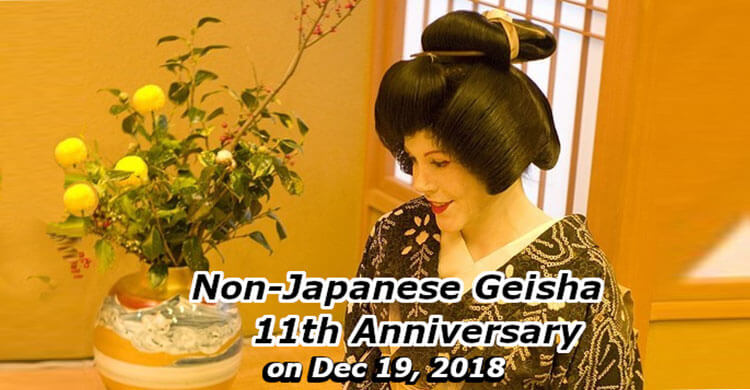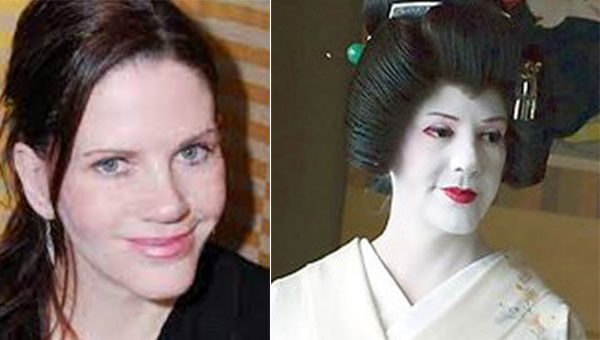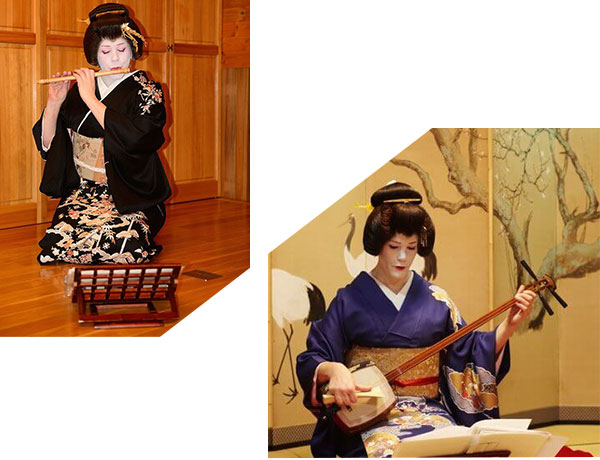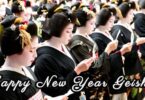Hi how are you? Today’s topic is about the first Non-Japanese Geisha, the caucasian Geisha in the notoriously secretive profession in almost 400 years.
Today is December 19, 2018, and 11 years ago today a woman from Australia made her debut as a geisha on Dec 19, 2007 in the Asakusa district of Tokyo under the name Sayuki. Consequently it is the 11th anniversary of her Geisha career in Japan.
I read an article in the paper about her life in Japan that she entered the unusual line of work – a 400-year-old tradition – after a lifelong passion for all things Japanese.
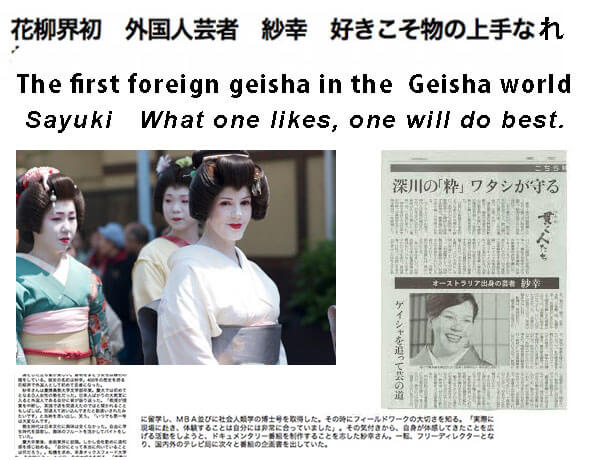
the article about her in the paper
Upon reading I was impressed by her perseverance and strong passion for Geisha, so I started to write it to post here.
Contents
Who’s Sayuki, Non-Japanese Geisha?
Sayuki was born in Melbourne, Australia, and first traveled to Japan for a student exchange programme, when she was 15.
She attended Japanese high school for a year initially. At that time, she became fascinated with Japanese culture and returned to Japan again to finish her schooling.
She took the entrance exam for Keio University after she finished high school, and became the first white girl to pass the entrance exam to Keio University.
Her first degrees were a B.A. in Human Science and a Dip. Ed. taken at Keio University.
She then completed an M.Phil. and a D.Phil. in Social Anthropology at the University of Oxford.
She has been a lecturer on Geisha Culture and other subjects at Keio and Waseda and Toyo Universities since 2008.
Before Geisha and after that, her activities
On 19 December 2007, she formally started as a geisha under the name Sayuki, which she states means “transparent happiness”, after a year of preparation and training.
She initially became a geisha as a year-long academic project. After she got her doctorate in Social Anthropology from Oxford, she started working on programs for broadcasters including NHK, the BBC or National Geographic Channel.
She initially became a geisha as a year-long project during which she planned to make a documentary following her progress.
After she got her doctorate in Social Anthropology from Oxford, she had been working on programs for broadcasters including NHK, the BBC or National Geographic Channel, and she planned to make a documentary about her life as a geisha.
However, things did not go quite to plan as she found it virtually impossible to make a documentary while being the newest member of a strict traditional hierarchy.
She has to put the program on hold while she trained.
She has said that she would very much like to make a documentary now on the Fukagawa Geisha District where she is working as a geisha, and a geisha mother, and which revived in 2015.
Sayuki’s formal debut and membership of a geisha house distinguishes her from American scholar Liza Dalby, who researched geisha and attended banquets as a geisha in the 1970s, but did not formally debut.
Sayuki did a rather long apprenticeship of 11 months. Nowadays many girls debut in just a couple of months.
She had taken lessons in tea ceremony, and as of 1 August 2011, was taking lessons in shamisen, singing, and her main art of yokobue(flute), which she chose after playing the flute for many years.
Graceful: Sayuki underwent basic training in the tea ceremony, dancing and music – specialising in the bamboo flute
After being in an Asakusa geisha house for four years, Sayuki applied for permission to have her own geisha house as her geisha mother was retiring due to illness.
But although Asakusa Geisha Association rules state that any geisha who has worked for four years can have their own geisha house they failed to follow their own rules and told Sayuki they would not allow a foreigner to become a geisha mother.
That led to Sayuki leaving. In February 2011, Sayuki ceased to be associated with the Asakusa Geisha Association.
However, as she still had banquet bookings, she continued to work at Asakusa teahouses together with Asakusa geisha for a year or two before moving to the Fukagawa Geisha District where she currently works as a geisha and has her own geisha house with three trainees.
In 2011, Sayuki opened a kimono shop in the Asakusa district of Tokyo.
In July 2013, she performed at the Hyper Japan festival in the United Kingdom. In the same year, she also visited Dubai and Greece.
In 2014, she opened a bar in Kutchan, Hokkaido. In 2015, she was invited to Brazil to train for six weeks and then participate in the Carnival.
What’s Geisha?
A geisha is a woman highly trained in the arts of music, dance and entertaining. Geisha is Japanese for “person of art.”
She spends many years learning to play various musical instruments, sing, dance and be the perfect hostess in a party of men.
A geisha, when she is working, is just that: the illusion of female perfection.
A geisha’s makeup, hair, clothing and manner are calculated to indulge a man’s fantasy of the perfect woman, and men pay huge sums of money to have geisha attend to their every whim.
Geisha are Japanese female entertainers following traditions that started around 400 years ago.
They perform specific ceremonial duties, such as serving drinks in a tea ceremony, talking to their clients, dancing, singing and playing instruments such as the three-stringed shamisen or the bamboo flute.
Geisha have to learn how to sit for hours in the seiza position (sitting straight)– with their legs tucked painfully under their bottoms.
The beautiful kimono gowns they wear for ceremonial occasions can be worth tens of thousands of dollars.
Rather than being seen as escorts, they are strictly entertainers. The profession started in the 17th century to act as cultured, educated female company.
Geisha were originally men, until the first female geisha appeared in Fukagawa District in the 17th century.
Geisha are also savvy businesswomen who charge around $400 to host parties for businessmen, politicians and people of money.
Sayuki’s and Geisha’s homequarter : Fukagawa?
Fukagawa, situated in Koto Ward, in Tokyo is noted for “Shitamachi”(downtown in Japanese way) and the biggest shrine in the Edo period (1603-1868), “Fukagawa Hachimangu” built in 1627 about 400 years ago.
The shrine is very busy with prayers and as a result, many shoppings, japanese-style restaurants and consequently entertainment districts including Geisha houses have appeared.
 Fukagawa Hachimangu Shrine
Fukagawa Hachimangu Shrine
With hangyoku (apprentices of Geisha) at Fukagawa

At a Japanese-style restaurant, “Okiya” in Fukagawa
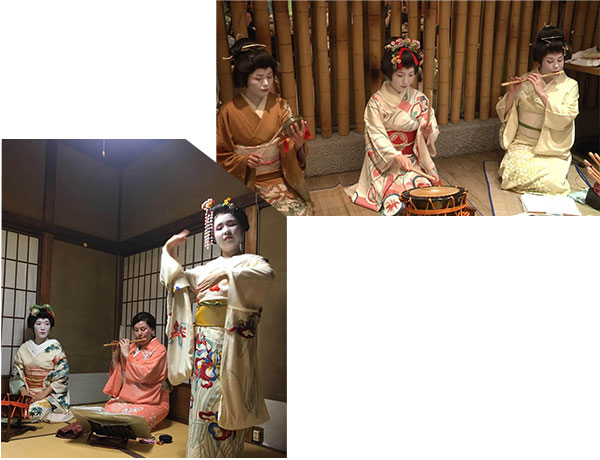
Sayuki is playing the flute
Fukagawa is the only district where girls can continue their university eduction or their high school education while training in a special program where they do normal lessons only until 2 pm.
Sayuki says she wants to be sure that the historic Fukagawa Geisha district continues while the older geisha who allowed her to have her own geisha house are still with them.
A mother of Geisha is giving a learner training

Fukagawa is currently recruiting new girls to become the next generation of Fukagawa Geisha.
Fukagawa Geisha are also doing new things: anyone can have a casual drink with the young geisha at a counter bar in Fukagawa for much less money that a banquet usually costs in a project called “Drinks with Geisha!” or “舞妓ちゃんと一杯!”
Foreigners can also come to the geisha house to watch the little geisha have their lessons in dance, music and tea ceremony.
Sayuki had to put the documentary program she first planned on hold while she trained.
We attract girls who would like to continue their education while training, and who like to practice foreign languages.
She has said that she would very much like to make a documentary now on the Fukagawa Geisha District where she is working as a geisha, and a geisha mother.
Fukagawa Geisha travel abroad very often, in 2019 visiting nine countries.
The number of geishas has shrunk drastically from 80,000 in 1920 to much less than 1,000 in 2018.
Sayuki says there has always been a mystique surrounding geisha.
Geisha do not get married and have a job that traditionally involved entertaining men (although these days geisha entertain anyone including women and families).
Sayuki is doing the job in Kyoto

It is not surprising that rumours around. But geisha are artists, and any relations beyond entertaining are geisha’s personal decision, and not part of the job.
Finally, We have three other blogs related to Geisha; “No.1 Geisha“
No.1 Geisha explaining everything about Geisha including “Is Geisha a prostitute?”

No.2 Maiko explaining everything about Maiko including “What’s difference between Maiko and Geisha?”

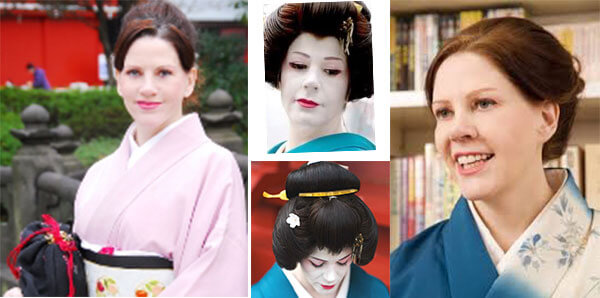
and “No.3 2020 New Year’s Resolution & Hospitality of Geisha from Kyoto & Tokyo” to be well worth to browse, thanks

